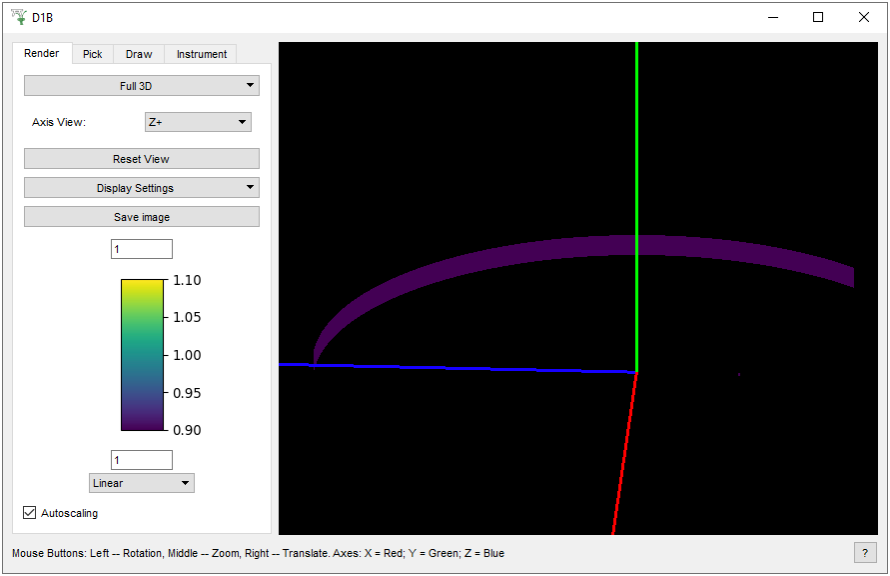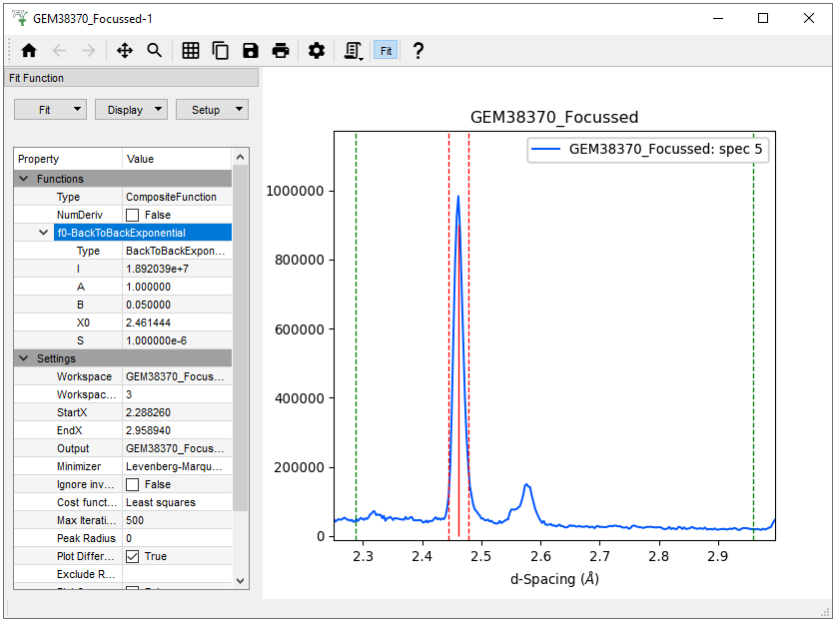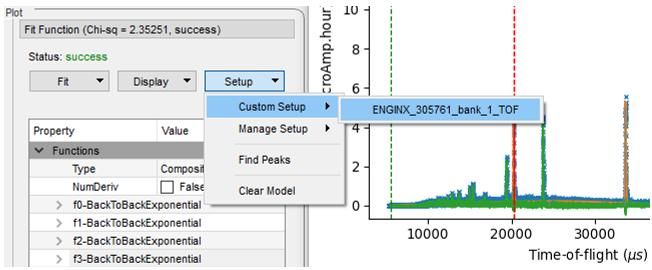Diffraction Changes¶
Powder Diffraction¶
New Algorithms¶
LeadPressureCalc to calculate the pressure of a sample given the d-Spacing of the Lead (111) peak and the sample temperature
PEARLTransfit for PEARL that uses a TransVoigt function to determine the temperature of a given sample
PaalmanPingsAbsorptionCorrection uses a numerical integration method to calculate attenuation factors for all Paalman Pings terms
CorelliCalibrationDatabase to save CORELLI geometry calibration to database
CorelliCalibrationApply to apply a CORELLI calibration table to CORELLI EventWorkspace
ClipPeaks to clip peaks, providing a background estimation.
PolDiffILLReduction to perform polarised diffraction data reduction for the ILL D7 instrument
D7AbsoluteCrossSections to separate magnetic, nuclear coherent, and incoherent cross-sections using spin-flip and non-spin-flip cross-sections, and to normalise D7 data to a given standard

Improvements¶

Nexus files from ILL’s instrument D1B can now be loaded (see InstrumentViewer)
Powder diffraction support (instruments D2B and D20) has been added to DrILL interface. See DrILL documentation for more information.
The height of the BackToBackExponential peak is now preserved when changing the FWHM sliders during fitting
PaalmanPingsMonteCarloAbsorption can now use tabulated density values, and allows for overridden X Sections
Add ability to store multiple alternative attenuation file paths in the PEARL YAML configuration file
Add
sample_emptyandsample_empty_scaleinto PEARL powder diffraction scriptsModify filenames of XYE outputs from running a focus in the PEARL powder diffraction scripts
Remove
_noattenworkspace that was produced by the PEARL powder diffraction scripts when run withperform_attenuation=TrueSpeed up focus action in ISIS powder diffraction scripts by saving pre-summed empty instrument workspace during calibration step
SNSPowderReduction now includes several different absorption correction methods
The vanadium absorption correction in SNSPowderReduction is now calculated using numerical integration rather than Carpenter method
In the creation of absorption input in SNSPowderReduction automatically gets information from sample logs
Added new absorption options from SNSPowderReduction to Powder Diffraction Reduction GUI
PDCalibration now supports workspaces with grouped detectors (i.e. more than one detector per spectrum)
AlignAndFocusPowderFromFiles copies the sample from the absorption workspace to the output workspace
Scripts for pixel calibration of CORELLI 16-packs produce a calibration table, a masking table, and a goodness of fit workspace
WANDPowderReduction now accepts a sequence of input workspaces, combining them to reduce to a single spectrum
The HB2AReduce now can save reduced data to GSAS or XYE file
PowderILLDetectorScan is corrected when treating multiple scans merged
The D7YIGPositionCalibration now can do the YIG Bragg peak fitting individually or simultaneously, or not at all and provide feedback on the initial guess quality
PDCalibration now intitialises A,B and S of BackToBackExponential if correpsonding coeficients are in the instrument parameter.xml file.
PaalmanPingsMonteCarloAbsorption can now make use of predefined sample and container geometries
Bugfixes¶
Dummy detectors in POLARIS workspaces no longer prevent unit conversion
Focus in PEARL powder diffraction scripts no longer fails if previous run has created a Van splines WorkspaceGroup
Fix out-of-range bug in FitPeaks for histogram data.
Fix bug to actually implement intended sequential fit of DIFC, DIFA, TZERO in PDCalibration.
WANDPowderReduction once again accepts multiple input workspaces and outputs a WorkspaceGroup when specified by user
Engineering Diffraction¶
New features¶
Added refined BackToBackExponential coefficients (from standard Ceria run) to ENGIN-X Parameters.xml so A, B and S are guessed automatically.
The plot pane in the Engineering Diffraction GUI can now be undocked from the main window, making this more clear, especially with the fit browser open.
The fitting tab now creates a WorkspaceGroup that stores the model string, the fit value and error on each parameter for each loaded workspace.
Sequential fitting now provided in fitting tab by average value of a log set in settings
Improvements¶

The default load path in the fitting tab of the Engineering Diffraction GUI is now set to the most recently focused files.
When a fit is successful, the model will be stored as a
Custom Setupin the fit property browser under the name of the workspace fitted.In the fit browser, the user is no longer asked before overwriting an automatically generated model
Custom Setup; it is overwritten.When a sequential fit is performed in the fitting tab, the status of the fit is updated in the fit browser.
The generic Sequential Fit button removed from fit menu (users should use sequential fit button below the table in the fitting tab).
Bugfixes¶
GUI Settings are now saved only when the
ApplyorOKbutton are clicked (i.e. clickingCancelwill not update the settings).For focussed data in the fitting tab, each sample log will only be averaged if the log exists
Single Crystal Diffraction¶
New Algorithms¶
ConvertQtoHKLMDHisto to convert from a QSample MDEventWorkspace to HKL MDHistoWorkspace with correct peak overlaying
SaveHKLCW for SHELX76 constant wavelength format
HB3AAdjustSampleNorm to convert DEMAND data to Q-space and allow the detector position to be adjusted by offsets
HB3AFindPeaks to find peaks and set the UB matrix for DEMAND data
HB3APredictPeaks to predict peaks for DEMAND data
HB3AIntegratePeaks used to integrate peaks from an MDEventWorkspace and apply Lorentz correction on DEMAND data
Improvements¶
Support added for DEMAND (HB3A) to PredictPeaks in order to handle additional goniometers.
Added refined BackToBackExponential coefficients (from standard sample) to WISH Parameters.xml so A, B and S are guessed automatically.
Bugfixes¶
SaveHKL calculates the DirectionCosines correctly again.
SaveHKL only recalculates TBAR if it’s not already populated in the input peaks workspace
Matrix diagonalization is no longer returning NaNs in certain cases. The diagonalization is used in CalculateUMatrix and IntegratePeaksMD